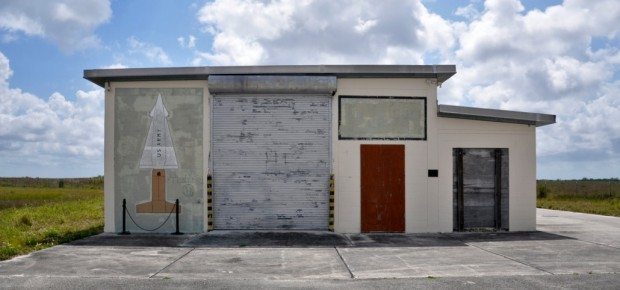The Cold War in Florida’s Wetlands

MIAMI — Consider, for a moment, the hole-in-the-donut: a confectionary absence that signifies a presence, a sort of vortex of meaning, potentially a Rorschach test.
Also the name of a place in the Everglades, the Hole-in-the-Donut (HID) is a 6,600-acre tract of wetlands. Its import, as a haven for destructive, invasive plant species amongst native ones, is not only ecological. The chill of the Cold War lingers there too, where a nuclear missile site once stood on high alert, aimed at Havana.
Christy Gast, for her show at Locust Projects titled Inholdings, created works that examine HID’s complex intermingling of histories. Building on her interest in what she calls “contested landscapes,” the show threads various intersecting narratives based on in-depth research of the HID, including environmentalism, paranoid geopolitics, and a gendered analysis of conflict.
Walking in feels like stepping into the Glades. “War Drums,” a large video installation, shows a panning shot of a pine forest as the horizon breaks, coming to land on a Afro-Cuban drummer on bongos. The camera moves slowly clockwise, eventually revealing a military corps-style drummer snapping snare rudiments. The juxtaposition speaks to the multivalent heritage of politics that imbue South Florida.
Behind the large projection screen hang two full-scale replicas of the Nike Hercules missile, intimidatingly positioned in the gallery at the audience’s chest (or head). 40 feet long with a wingspan of 10 feet, they are made with fabric that has a botanical pattern designed by Gast, one that softens their aggressive posture.
The textile, printed and stitched by Gast, tells the ecological drama of the HID: the Brazilian pepper, a non-native plant that choked out other species, is overlaid on top of tomato bushes, referencing the bygone days of harvest. Both compete for area on the missile sculptures with lovegrass, a native species that has started to return to the area.
The pattern on the missiles is orderly, arranged in a way you might find on a tablecloth. This conjunction — the phallic brutality of war machines juxtaposed with the florid, domestic greenery — highlights the sexual allusions and machismo that abounded throughout the nuclear era.
It’s well documented that both low and high-ranking military referenced the size of their missiles and the shape of their warheads, a fact that was mocked towards the end of Stanely Kubrick’s Dr. Strangelove (1964) when Major T.J. “King” Kong rides the bomb down like a cowboy. Though this explicit, sexualized discourse has changed, it is something to consider when thinking about a post-Crimea world.
With Inholdings, Gast disarms the bomb and unearths an uncanny local history of the Cold War. She strikingly communicates the shape and character of conflict by explicitly linking chauvinistic policy, ecological invasion, and the need for a softer, more compassionate approach to political affairs.
Christy Gast’s Inholdings at Locust Projects (3852 North Miami Avenue, Miami) continues until April 12.